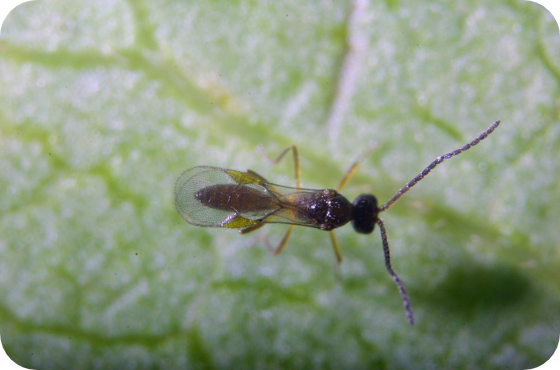Quality Products
Fast Delivery
Premium Service
Written by Kevin van Kester | Last update: 15. February 2023
The parasitic wasp Aphidius colemani stands out as one of the most effective solutions in aphids natural pest control. This wasp specializes in targeting and parasitizing smaller aphid species, making it a key player in organic aphid control in greenhouse environments.

With its superior ability to detect and target small aphid species, the ichneumon wasp Aphidius colemani is known as a highly effective natural enemy for organic aphid control. Often, by the time aphid infestations are identified, they have already been addressed by this vigilant wasp. Aphidius colemani is so efficient that even newly formed aphid hotspots are quickly managed. This remarkable effectiveness makes Aphidius colemani a popular choice for preventive aphid biocontrol in various crops.
Aphidius colemani effectively controls the following aphids:
The parasitic wasp uses its ovipositor to insert an egg into an aphid. As the egg develops, the aphid or nymph enlarges and eventually transforms into a grey-brown mummy. Finding these mummies in your crop indicates that the parasitic wasp has effectively done its job. Once the egg hatches, the wasp emerges through a self-made exit at the rear of the aphid. Typically, each parasitic wasp can control around 300 aphids, making it a great solution for greenhouse aphid control.
If you’ve just noticed aphids on your plants, introducing Aphidius colemani directly can be highly effective. This parasitic wasp thrives when the temperature averages between 20 and 25°C. While it already starts parasitizing aphids at temperatures as low as 13°C, its activity declines significantly when temperatures rise above 30°C.
Aphidius colemani should be released promptly after receiving it, as it doesn’t have a long shelf life. If you need to store it temporarily, ensure that the product is kept at a temperature between 8 and 10 degrees Celsius, and do not exceed 24 hours of storage time.
Aphidius colemani is named APHIcontrol and is supplied in bottles containing various quantities of mummies, with buckwheat serving as the carrier material. This buckwheat ensures that the parasitic wasps are well-protected during transit. It's important to consider the effects of moisture, as well as any potential damage from shaking or bumping of the package.
Once you’ve opened the bottle of Aphidius colemani, distribute the mummies over the infested areas. Be sure to avoid placing the material on surfaces exposed to direct sunlight or damp conditions. To ensure optimal hatching of the mummies, it’s advisable to keep the bottle in a sheltered spot within the crop. For an effective application, consider using introboxes to introduce the pupae.